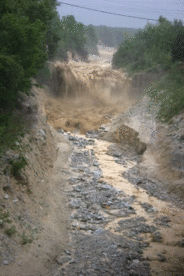
Masses in motion: debris flows and bedload ¶
In steep mountainous regions, mountain torrents represent a significant source of danger: when it rains heavily, the torrents sweep away destructive quantities of rock and earth. We analyse these processes in order to develop models (simulations) and warning systems.
Inhalt ¶
It happens mostly during thunderstorms: a slurry-like mixture of water, fine matter and rock intermittently pours into villages and onto roads and railway lines, often at high speed. Debris flows, also commonly known as mudflows, are especially feared forms of the so-called bedload transport processes. All together they cause damage costing over CHF 100 million each year.
The largest known debris flows of the Alps have swept away up to half a million cubic meters of material and deposited it in the valleys. One would require over 40,000 trucks to remove it. Debris flows carrying an amount of material that would fit into around 1,000 trucks are not uncommon.
Experiments and long-term measurements ¶
To mitigate the risk from debris flows and to be able to take protective measures, it is essential to know exactly how these processes work. Therefore. we conduct experiments and take long-term measurements. For this purpose, we have developed new types of measuring systems, such as a debris flow scale.
Thanks to the unique data from our installations in our debris flow laboratory and outdoors, we have been able to enhance the avalanche modelling software RAMMS with a debris flow module. It calculates the potential flow and breakout paths of a debris flow depending on rainfall, terrain and slope gradient.
Observing bedload ¶
In the Erlenbach in the Alptal (SZ), we have been studying the transport of stones, debris, but also sand or wood in torrents for over fifty years. This is one of the longest such observation series worldwide, which accordingly makes it valuable for studies of these transport processes. Here also, new types of measurement method have been used, such as automatic basket samplers, which catch bedload from the stream for a specific period of time during flooding in order to estimate its volume and grain composition.
Our research provides a scientific basis and is helpful for assessing risks and developing protective measures. Given that it is a question of weighing up costs on the one hand and risk on the other, we also look into how the public address the risk and what their opinion is of the countermeasures.
Related Topics ¶
Contact ¶
Research groups
- Mountain Torrents and Mass Movements
- RAMMS Rapid Mass Movements
- Alpine Remote Sensing
- Social Sciences in Landscape Research
- Environmental and Resource Economics

